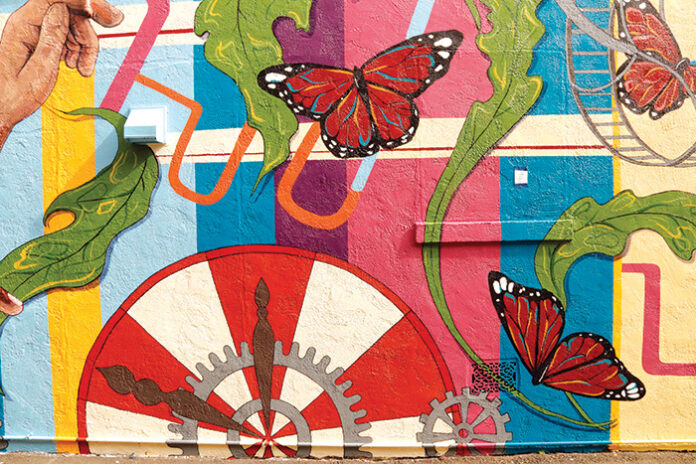A complex, densely packed mural of the immigrant experience—the hands that pick the crops, the wheels that drive them, butterflies escaping everywhere—will be officially unveiled on Friday, July 8, on the alley wall of Black Oak Coffee in Healdsburg.
The mural contains a large flowing series of images signifying the immigrant history of Healdsburg and what recent changes have brought to the area, according to its creator, Rima Makaryan.

Makaryan leapt into the county’s awareness with her 2019 mural at Montgomery High, where she became involved with the county’s Junior Commission on Human Rights.
Called “The Dreamer,” the hard-to-find wall painting is an artistic celebration of the immigrant community—a woman with multi-hued skin and hair, surrounded by a flock of butterflies.
As the young artist said at the time, “We want to spread the project onward… the idea is these butterflies around her are going to take flight and go off to different parts of Sonoma County, and even perhaps beyond that.”
Those butterflies have landed in Healdsburg, the northernmost reach (so far) of the Monarch project.
Volunteers have been working on the 12-by-53-foot mural most days since June 13, climbing the scaffold with trays or palettes of paint and refining with fine brush what will be celebrated at a 5pm July 8 ceremony in the walkway between the café and Gold Bloom jewelry.
The 324 Center St. location has long been a coffee-lover’s destination, and Black Oak owner Jon Frech and local manager Beryl Adler are all in on the mural project, sponsoring the effort to bring something to the community—and to create outside seating under the city’s “parklet” program.
Calling the walkway between the Masonic Building and Gold Bloom a “nondisclosed alley,” Adler explained, “Rather than taking up more spaces of parking in the front, I reached out to the city to use that as part of the parklet program.”
Frech, whose flagship Black Oak Coffee Roasters is in Ukiah, said they wanted to do something for the community, and that included the immigrant community.
“You know we have a lot of employees in the service industry that are first-generation immigrants, and Rima’s work really spoke to that,” he said.
They contacted Makaryan about this project a few months ago when they were re-establishing their business after the COVID restrictions. The café had its eye on the passage on the building’s north wall as a good place to add outdoor tables and chairs under the city’s parklet program.
“Having public community-based art there was an intentional bonus,” said Frech. “People that work in kitchens and service industry jobs walk through this alley to get to work, so if they walk by this everyday, hopefully it makes them feel more seen in the community.”
Makaryan’s commitment to art as a form of activism took wing in 2019, during a year of Black Lives Matter and rising social awareness. Said Makaryan, now 20 and a student at Stanford, “The idea was how can we use art as a different way to talk about these political issues, and tapping into the humanity behind politicized topics.”
Her social-activist muralism is descendent from the Mexican muralists of 100 years ago, Rivera and Orozco, but the young artist actively involves others in the creation of the murals. Her imagery now, as it was then, is of human aspiration, tied to the metaphor of the monarch butterfly; and projects cultivate volunteers and sponsors to make public art out of shared dreams.
It is not the opus of a single artist, but a community.
Why a butterfly? “The monarch butterfly is itself a symbol of immigration and migration,” said Markaryan, “because it represented something so fragile, but also strong… it provided a positive way to look at immigration, which at the time was demonized, and the people were lost in the process.”
She is an immigrant herself, having come to the U.S. at the age of 8 with her family from Armenia. Following the success of “The Dreamer” at Montgomery, she continued to use the metaphor in her subsequent work, and as she put it, “eventually branded the entire organization around the monarch butterfly,” a metaphor for immigration and creativity.

That led to more activist/art projects, including murals in Boyes Hot Springs near Sonoma and Rivertown Revival in Petaluma, several in Santa Rosa and a whimsical piano in Windsor.
The larger projects, such as the still-untitled one in Healdsburg, begin with her designs in digital, which are then transferred to a plot for volunteers to fill in the assigned shapes and colors, a process that results in the active involvement of the community in the work.
Local artist Chris McGee is working brush-to-roller with Makaryan as production manager overseeing logistics on the project, and they are aided by three “junior leads,” young area artists who will gain professional experience and training in public art projects.
They are helped out by a rotating cast of volunteers, many of whom seem to have found out about the project through social media—facebook.com/socomonarchproject is a good place to start—and some passersby struck by the activity, who joined in on the spot.
Markaryan outlined some plans for the July 8 reveal, scheduled for 5–8pm Friday night: music, refreshments and spoken word, a dedication and reveal of the finished mural—and an announcement of the project’s name, as yet still undecided. Sponsored by Black Oak Coffee and the Healdsburg Chamber of Commerce, with wines from Cartograph, the event will serve as a fundraiser for The Monarch Project, and is open to the community.
The next day, Black Oak will set up six tables and up to 20 seats, with QR codes on the tables, so patrons can order and pay without necessarily going inside. Light breakfasts and lunch plates, and coffee-compatible bites are available during business hours, 7am to 7pm, in the shaded walkway, dominated by the latest Markaryan Monarch mural.
And if the city’s parklet program is canceled or changed, forcing those tables and chairs inside? Adler shrugged. “Things change all the time. The only thing that would change would possibly be the seating outside, depending on the part of the program. But the most important piece is Rima’s work out there, which will never change.”









